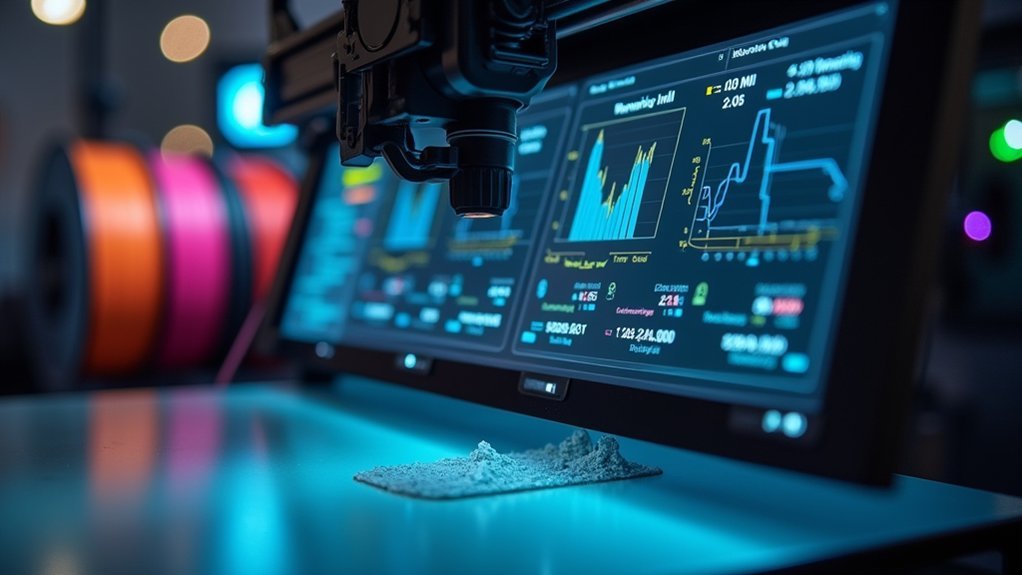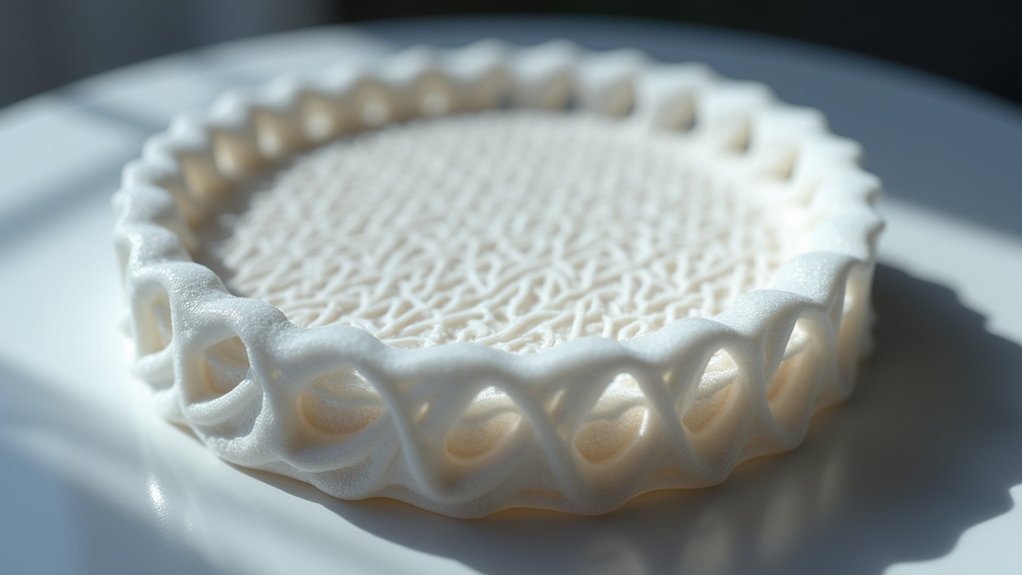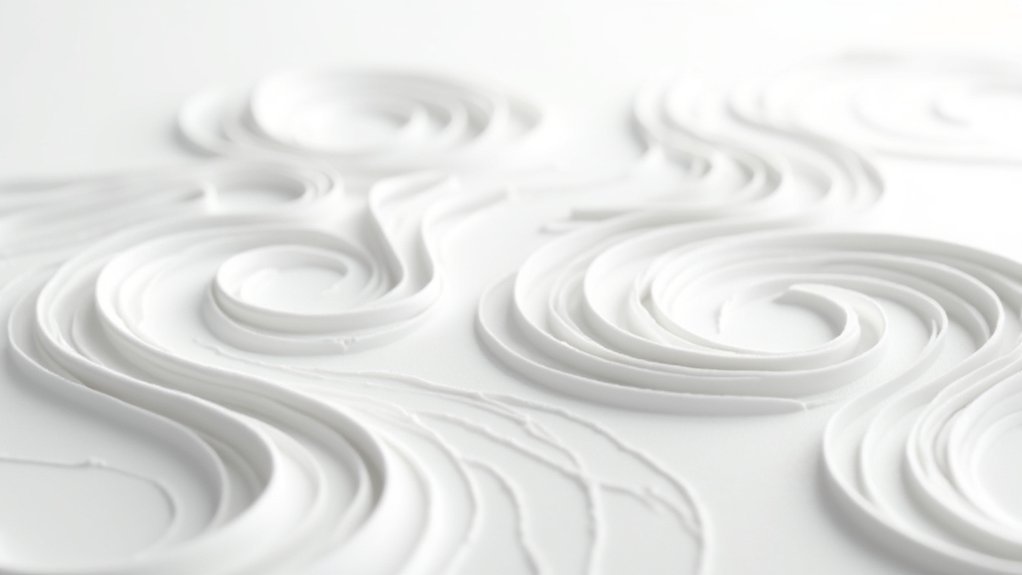You’ll achieve perfectly smooth top surfaces by configuring these five monotonic infill settings: set your infill pattern to monotonic for top layers, reduce print speed to 120mm/s with acceleration at 2000mm/s², enable ironing with 15-20% flow rate, adjust top layer speed to 60mm/s, and calibrate your flow rate starting at 100% with 1-2% increments. These settings eliminate lawnmower effects and visible layer lines that plague traditional patterns. Master these fundamentals to access advanced techniques for professional-quality finishes.
Understanding Monotonic Infill Pattern Advantages

When you’re seeking superior surface quality in your 3D prints, monotonic infill delivers consistent filament placement that eliminates the visual inconsistencies plaguing traditional patterns like rectilinear infill.
This technique minimizes the lawnmower effect, creating a smooth top surface without the uneven textures that compromise your final 3D print’s appearance.
Monotonic infill excels at bridging perimeters around holes, reducing gaps and improving the quality of the top layers.
You’ll notice fewer visible layer lines and achieve a more professional finish without requiring ironing settings or post-processing.
The consistent directional flow creates superior extrusion patterns that enhance both structural integrity and aesthetic appeal.
Popular slicers like PrusaSlicer and Cura have adopted this monotonic approach specifically because it delivers remarkable improvements in surface smoothness and overall print quality.
Optimizing Top and Bottom Layer Settings
Achieving ideal monotonic infill performance requires precise configuration of your top and bottom layer settings in your slicer software.
You’ll need to adjust several key parameters beyond the default settings to maximize surface quality. The monotonic top layer pattern works best when you enable ironing for an exceptionally smooth top layer finish.
Essential configuration steps include:
- Set your infill pattern to monotonic for both top and bottom layers
- Adjust ironing flow to 15-20% for best material distribution
- Enable “Allow crossing perimeters” to improve hole filling
- Configure monotonic ironing order for consistent directional movement
These adjustments guarantee your extruder follows a consistent path, eliminating random movements that create surface inconsistencies.
When properly configured, you’ll notice dramatically improved surface finish compared to traditional infill patterns.
Configuring Print Speed and Acceleration Parameters

Since monotonic infill requires consistent extruder movement patterns, you’ll need to fine-tune your print speed and acceleration settings to prevent quality degradation. For ideal flat top surfaces with Monotonic Ironing, reduce your print speed to around 120mm/s for PLA materials. Lower acceleration settings enhance precision and prevent defects that compromise layer height consistency.
| Parameter | Default Value | Recommended Value |
|---|---|---|
| Print Speed | 150mm/s | 120mm/s |
| Acceleration | 3000mm/s² | 2000mm/s² |
| Jerk Control | 8mm/s | 6mm/s |
| Infill Speed | 100mm/s | 80mm/s |
| Top Layer Speed | 80mm/s | 60mm/s |
These settings enable precise filament deposition and improved layer adhesion. Monitor your prints continuously and adjust these parameters iteratively to achieve the best results when combining monotonic infill with advanced features.
Combining Monotonic Infill With Ironing Features
Building on these optimized speed and acceleration settings, you can now enhance your print quality even further by pairing monotonic infill with ironing features.
This combination creates exceptionally smooth top layers by eliminating the lawnmower effect while ironing passes follow the same directional pattern as your monotonic infill.
When you enable monotonic ironing order, you’ll achieve:
- Consistent filament flow across top surfaces
- Reduced visible layer lines and print inconsistencies
- Superior finish quality for flat surfaces like nameplates
- Seamless changes between infill and ironed areas
You’ll need to experiment with both monotonic and ironing settings since different materials respond uniquely.
While print times may increase, the dramatically improved surface quality makes this combination particularly valuable for visible top surfaces requiring professional-grade finishes.
Material-Specific Calibration Techniques

While monotonic infill settings greatly improve surface quality, you’ll need to fine-tune your approach based on your specific filament material.
For PLA, set your temperature range between 190-220°C to prevent stringing while maintaining proper layer adhesion.
PETG requires higher temperatures at 230-250°C for ideal flow characteristics. Start with 100% flow rate and adjust in 1-2% increments until you achieve consistent extrusion.
Your layer height considerably impacts monotonic infill effectiveness—use 0.1-0.2mm for the smoothest finish on your top surface.
Test different infill density settings between 10-20% through small calibration prints.
This systematic approach helps you identify the perfect combination of settings that delivers consistently smooth results for each filament type you use.
Frequently Asked Questions
What Is the Best Top Surface Pattern for Smooth Surfaces?
You’ll get the smoothest top surfaces using monotonic infill patterns. They eliminate the lawnmower effect by laying filament in consistent directions, reducing inconsistencies around holes and creating more uniform finishes than traditional rectilinear patterns.
What Is Top Surface Monotonic Solid Fill?
You’ll find top surface monotonic solid fill lays filament in one consistent direction per layer, eliminating the lawnmower effect while creating smoother, more visually appealing finishes on your print’s top surfaces.
Is 40% Infill Too Much?
You’re using excessive infill for most prints at 40%. You’ll waste material and time without gaining meaningful strength. Drop to 10-20% for decorative items or keep 40% only for functional parts needing durability.
How to Get a Smooth Top Layer in 3D Printing?
You’ll achieve smooth top layers by enabling monotonic infill patterns, using ironing features, calibrating your extrusion settings properly, and reducing print speeds. These adjustments guarantee consistent filament deposition and eliminate visible surface inconsistencies.





Leave a Reply